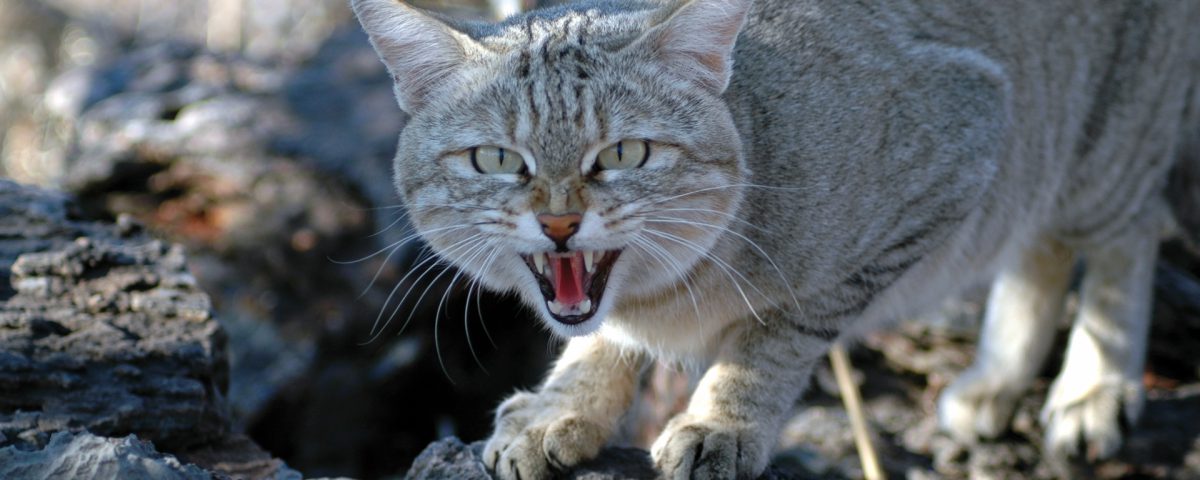
Damaraland Camp long-listed for African Responsible Tourism Award
March 6, 2017
Namibia Wildlife Resorts
March 7, 2017Text and photographs Tim Osborne
Popular wisdom and speculation tell us that the ancient Egyptians domesticated the African wild cat Felix lybica 5 000 years ago into what today are our household pets. If you look at any source, you’ll find references of how the cats were caught and put into granaries to keep mice and rats in check. Why they stayed there is not known and how they became pets of the Egyptians is also not known. But the cat did have a special place in Egypt where they were worshiped as gods, and I’ve seen statues of their likeness at the Temple of Karnak at Luxor.
T
he African wild cat differs from the domestic cat by having orange ears, black bottoms to their feet and two black stripes crossing on the front legs. They stand taller than the domestic cat, so when sitting upright, the long front legs are noticeable. Their colouration is a mixture of grey and orange with darker stripes on the body.
We’ve had some experiences with an African wild cat that might shed light on how the contact and domestication may have occurred. Our lodge is built on a rocky bluff where we occasionally hear wild cats caterwauling during the mating season and sometimes caught a glimpse of one. One evening at sundown we observed a female wild cat walk past the lapa. We put some meat scraps on a rock next to the lapa and watched as she dashed in to snatch the meat and ran off to consume it. This went on for two weeks, with the cat gradually becoming less timid. Then one evening as we watched the female approach the food, a male wild cat ran in, chased her off and sat down to climb into her meat. He then looked up at us as if to say “Feed me!” I fetched another piece of meat and threw it near the cat. He backed off a little, but came right back to devour the tasty morsel. The male cat took over and the female never did come back.
Over the next few months we placed the meat closer and closer to the edge of the lapa. The cat often sat in the nearby bushes at sundown, just waiting for us. Of course, not content to have the cat two metres away, I began dropping the food closer and closer until he had to leap up to the lapa to get it. After a while he was quite relaxed with our presence. However, every time the cat jumped up on the lapa he hissed and growled as part of the procedure. We soon realised that we were not domesticating the cat; he was domesticating us!
It seemed this cat was partially attracted to the smells of Mexican cooking and sometimes actually took a few steps into the kitchen when the door was open. He especially liked to eat tacos and stir-fry, so he became Tomas the gourmet African wild cat.

Often at sundowner time we found Tomas lying down on the edge of the lapa waiting for us. On hot days he came in earlier and we would find him on the cool tile floor, stretched out flat. Tomas never let us pet or touch him. If I offered a piece of meat held between my fingers he simply lashed out with his paw, claws extended. I learned to drop the food fast.
Tomas was actually the ideal pet, as we could leave our lodge for a month and he would revert to eating the local birds and mice. A few days after our return, he would be back at the lapa looking for his dinner. He was quite photogenic and most of our guests got to see him. One of the odd things about Tomas was that he never purred or meowed like domestic cats; he just hissed and growled. He preferred lying on hard rocks to sleeping on our furniture, although he had plenty of opportunity.
Tomas was a full-grown adult when he came to us. Sadly, after five years, he became older, thinner and finally disappeared one rainy evening in February 2009. This is the story of how a wildcat domesticated us. It might well be that a similar event took place in Egypt thousands of years ago.

This article was first published in the Flamingo November 2012 issue.


